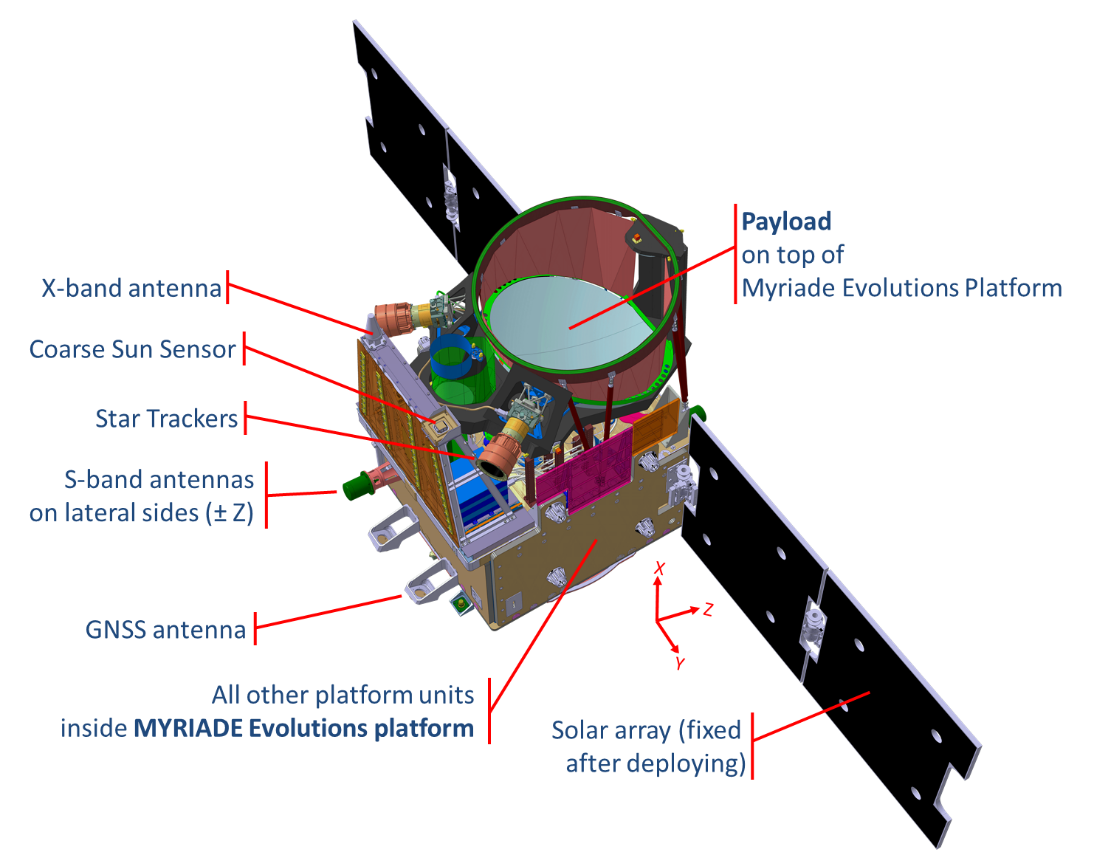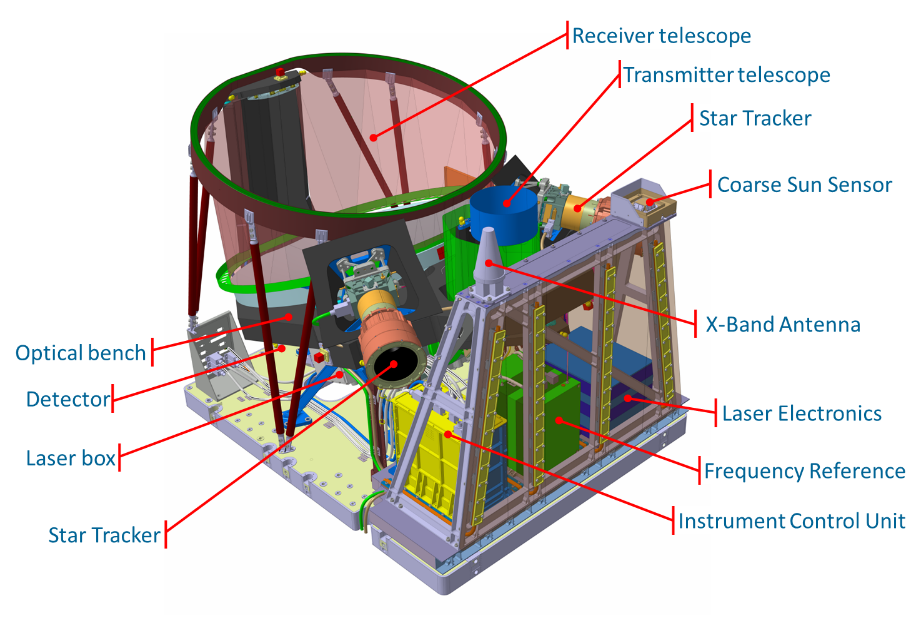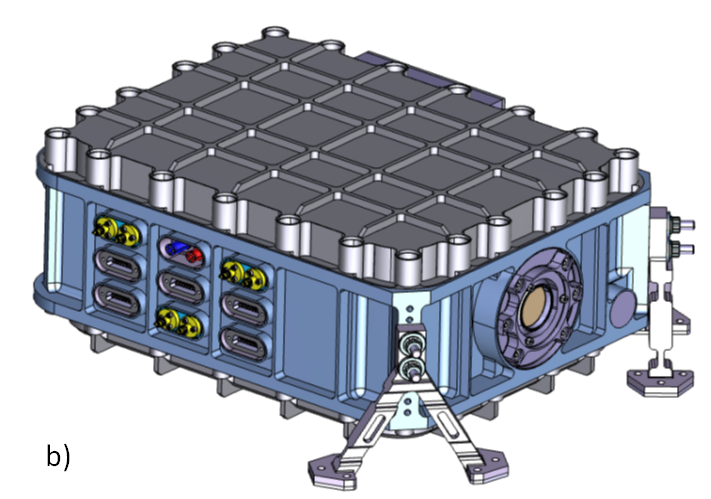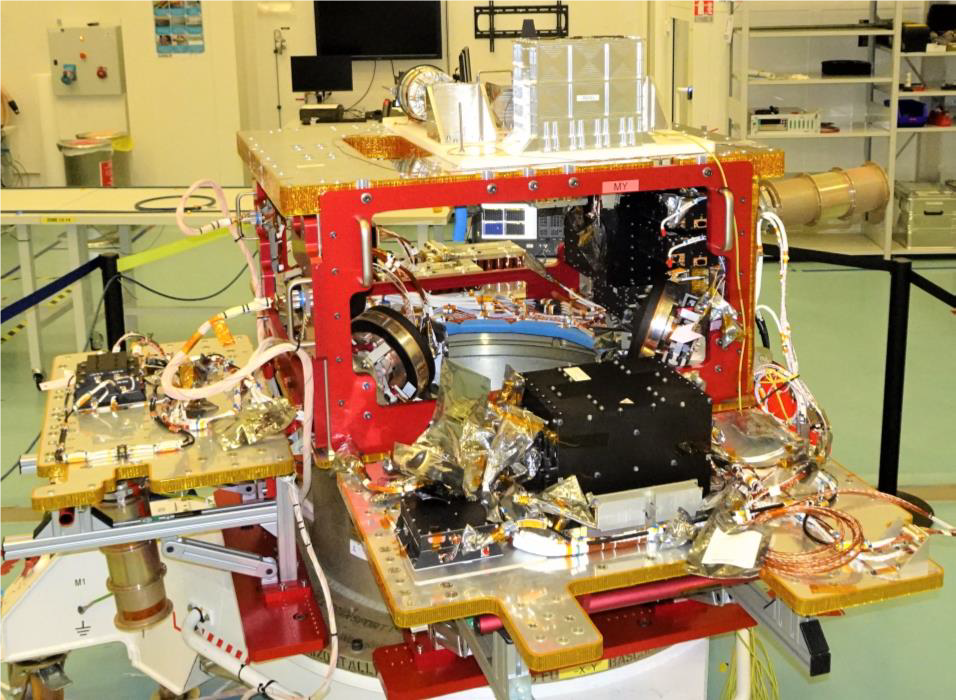The satellite instrumentation
To share the philosophy of a joint development between France and Germany, the satellite uses a modular approach with a clear separation between the payload provided by Germany (DLR) and the platform module from France (CNES).
The space segment of MERLIN is comprised of a mini-class satellite carrying only one scientific instrument, the Integrated Path Differential Absorption (IPDA) lidar system operating in a near-nadir-viewing configuration.
Payload
All optical units (laser head, telescope, star tracker) are mounted on a optical bench with an isostatic interface to the spacecraft panel. Other subsystems, such as the instrument control unit, frequency reference unit, and laser electronics unit, will be mounted on a secondary structure. The online and offline pulses in the 1.64 µm spectral domain are generated by the laser head consisting of an OPO that is pumped by a pulsed single-frequency Nd:YAG laser at 1.064 µm.
By means of injection seeding using a continuous wave single-frequency laser system at 1.64 µm, the OPO itself provides spectrally narrow pulses which can be tuned to the desired frequency position within the absorption profile of the selected molecular transition. The spectral properties of the transmitted OPO pulses are controlled by means of the frequency reference unit.
To ensure narrow-band and spectrally stable operation of the OPO, its cavity must be matched to the frequency of the seed lasers. A CH4-gas cell in combination with an interferometric standard serves as a frequency-calibrated wavemeter. This enables spectral control of both the seed lasers and transmitted pulses on a shot-by-shot basis.
The IPDA lidar method is not free from “internal” radiometric calibration needs. It requires knowledge of the ratio of outgoing online and offline pulse energies at similar accuracy as requested for the measurement of the lidar signals. In order to account for ageing of the detector, this measurement will be performed by the same lidar detector. For this purpose, an integrating sphere is used to attenuate the calibrating laser beam to a power level that is comparable to the received lidar signals. The integrating sphere gives rise to a speckle pattern, which is not stationary within the relevant timing sequence due to small temperature drifts. Investigations show that this kind of error source can sufficiently be suppressed through the implementation of a synthetic high frequency speckle generator. Such device can be regarded as an additional white noise source and therefore does not increase systematic errors in the IPDA lidar measurement.
Platform
The platform considered for MERLIN strongly benefits from the MYRIADE Evolutions Program, which is an enhancement with respect to the original MYRIADE concept of small satellite series. The new concept offers the MERLIN instrument payload to allocate more power (around 150 W) and a greater mass (around 140 kg).
The main improvements are:
- a new structure compatible with a satellite mass up to 470 kg
- an increased solar array capacity and power supply
- a more effective propulsion system; an improved Attitude and Orbital Control System (AOCS)
- an increased capacity for payload data storage; improved reliability figures
- obsolescence handling and finally compatibility with low orbits (addressing atomic oxygen issues).
The lidar payload is housed on the upper panel of the platform. Some platform units are located close to the instrument: two star tracker optical heads with their baffle, two solar arrays, one X-band antenna and a sun sensor notably to take into account a sun avoidance mechanism.
Orbit
The selection of the MERLIN orbit is driven by the following considerations. To reduce sampling biases in the estimation of the methane sources, rather homogeneous measurement coverage in space and time is generally preferred.
Of particular importance are measurements over ecosystems such as tropical and boreal wetlands, which are poorly monitored by the existing surface network. However, the measurement coverage of a lidar will be limited by the overpass positions and frequency, and the presence of optically thick clouds. As an optimal compromise, a near-polar orbit to observe all latitude zones providing good samples of all climate zones over the continents and the oceans is chosen. Even though the sampling of diurnal variations is not the focus of the mission, the choice of a sun-synchronous orbit at a local time of the ascending node LTAN = 06:00 or 18:00 is preferable. The relatively stable sun-illumination condition at time of day ensures a stable thermal environment and helps to mitigate possible biases related to instrument frequency drifts or transmitter pointing issues. At both 06:00 and 18:00 local time, the low sun elevation angle reduces the amount of solar flux reflected from the surface to the satellite and thus limits the noise caused by the background light.
Of key importance is the selection of a low orbit height of about 500 km in order to maximize the signal strengths that directly impacts measurement precision considering the limited power of the OPO. Orbit cycling of 28 days allows for overpasses within a circle of 50 km of all ground reference stations on a monthly basis which will help the long-term validation of the satellite measurements. The eclipse phase will be ≤20 min for each orbit during winter times, which in principle allows continuous operation of the instrument throughout the mission.
Parameters
Satellite and orbit parameters for MERLIN and Optical Parametric Oscillator (OPO).
| Platform | MYRIADE Evolutions |
| Satellite Mass (Platform+Payload): | 430 kg |
| Satellite Power (Platform+Payload): | 500 W |
| GPS receiver: | 2 sensors |
| Star tracker: | 2 optical Heads |
| Payload: | IPDA Lidar for Methane |
| Mass allocation: | 140 kg |
| Power allocation: | 150 W |
| Laser transmitter type: | Nd:YAG pumped OPO |
| Online frequency: | 6076.9896 cm−1 |
| Offline frequency: | 6075.97 cm−1 |
| Pulse energy: | 9.5 mJ |
| Pulse length: | 20 ns |
| Time lag between on/offline transmission: | 250 µs |
| Pulse-pair repetition rate: | 20 Hz |
| Receiving telescope size: | 69 cm |
| Detector type: | Avalanche Pin Diode (APD) |
| Spot size on ground | 100 m (90% encircled energy) |
| Orbit: | Sun synchr. polar, low Earth orbit (LEO) |
| LTAN: | 06:00 h or 18:00 h |
| Height: | ~500 km |
| Inclination: | 97.4° |
| Repeat cycle: | 28 days |
| Attitude control: | 3 axis stabilized |









